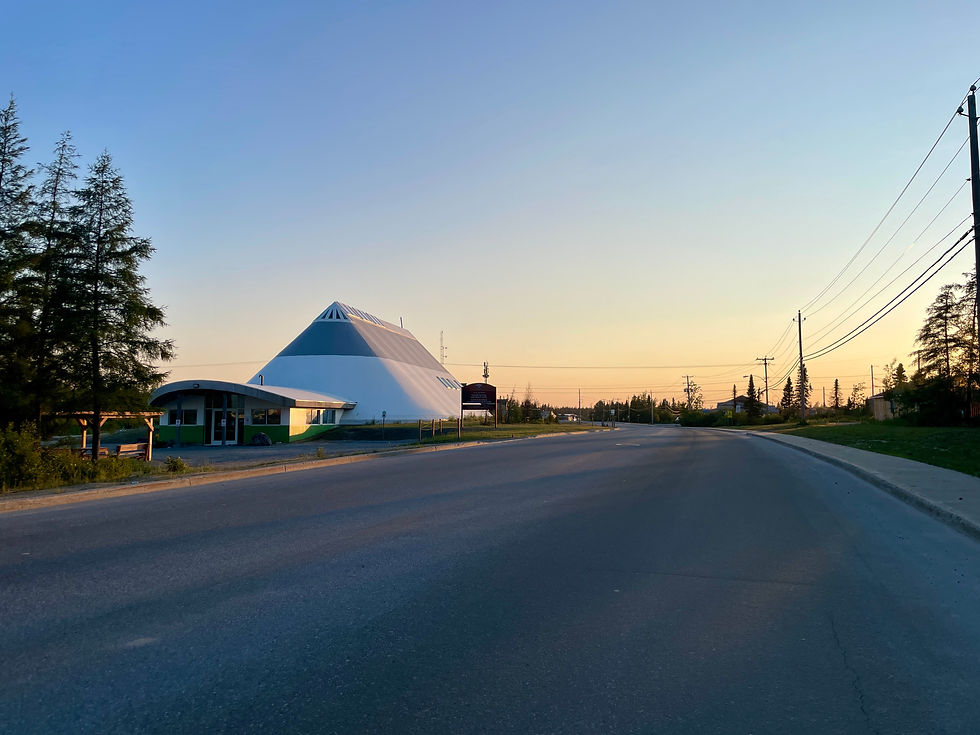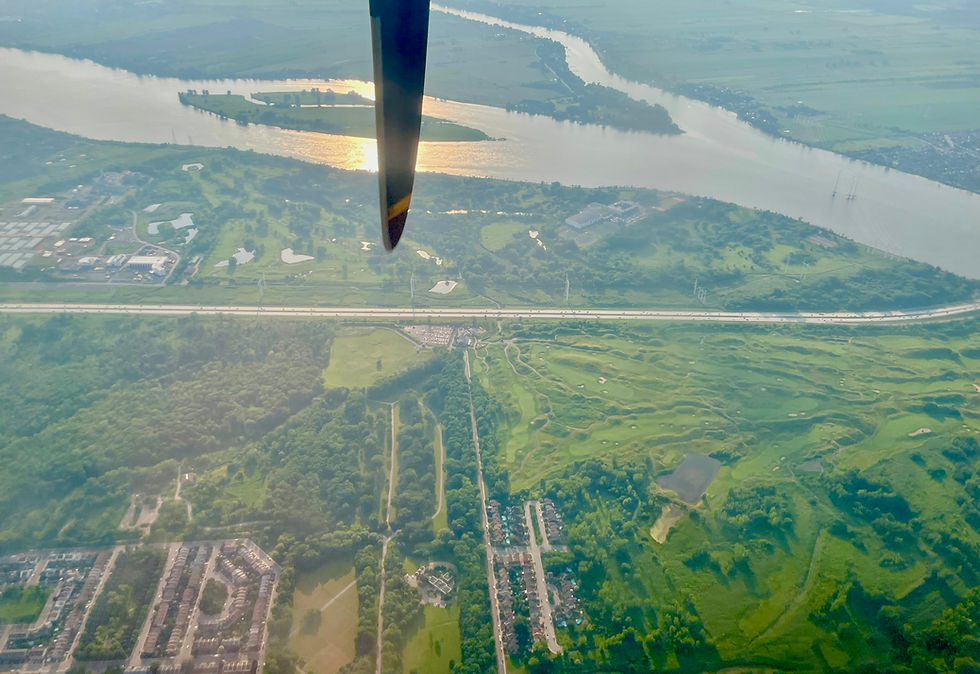Chisasibi: Full Circle and Building Ahead
- Michelle Kwok

- Oct 1
- 7 min read

I had not been back to Chisasibi since residency. My first visit was as a senior resident, at a time when travel to the North was still limited by the pandemic. For more than a year I had been waiting for the chance, asking Cree patients admitted under our care what life was like in their community, and reading literature to try and understand. But without context, it was difficult to picture. Eventually I let go of the idea, assuming it might never happen. Then, out of the blue, came an opportunity to travel with an internist.
Everything about that week felt unfamiliar. On the first afternoon, a nurse placed a stack of charts in front of me that seemed half my height. “These are your patients for today,” he said. The cases were complex, the system unfamiliar, and the evening ended with me pushing the charts back to the archives in a wheelbarrow through the snow. Yet despite the steep learning curve, that week became a catalyst in shaping my path as a physician learning to build projects with and for the community.
Monday, July 7, 2025

The day began at the small Air Creebec terminal, where Dr Adhora Mir, an allergy/immunology fellow in training, and I waited to check in for our flight to Chisasibi. Instead, I was told my ticket had been switched from direct to a short layover in Whapmagoostui (Great Whale). No one could explain what happened, but it felt like an unexpected gift.
The plane carried only three passengers. Montreal had been stifling hot the day before, but when we stepped out of the aircraft the northern air was cool and clear, like the freshness of spring. At the airport, Marianne Martin from Minnie’s Hope was waiting. She first brought me by the Centre d’études nordiques, hoping we might find JP (Jean-Philippe Lachance), but he was out in the field. Instead, she offered to show me the new Minnie’s Hope building.
Minnie’s Hope is an example of a program led with and for the community. The idea began in 2014, when Dr Johanne Morel, who had already spent decades flying north, heard a Cree leader on the radio asking, “Is anyone listening? Is anyone ready to help?” Those words stayed with her. She began gathering others but also made space for the community to lead.
When I first visited two years ago in Whapmagoostui, Minnie’s Hope was still operating out of a church building. This past January, it officially celebrated the opening of its new building. Stepping inside, the difference is clear. There is no check-in desk or waiting room. A play tipi sits in the corner of the main room, and a table offers bannock and Labrador tea. Marianne explained, “We want people to feel comfortable, even if they’re just here for tea.” The therapy spaces carry the same spirit. In the sandplay room, trays are surrounded by shelves of miniatures, with a chair set quietly to the side for the therapist. As I looked through the collection, Marianne told me how one toy gun had once been replaced with another that reflected local history more accurately.
As we wrapped up the tour, JP returned my missed call. He had been in an area with no cell service and came to the airport with Roman, a visiting student. We had a short conversation before it was time to catch my flight onward. In Chisasibi, I was picked up at the airport by Gail Winchester, a nurse from Specialized Services. We then went to the clinic where I joined Adhora.

As I was finishing my notes, I noticed an allergy testing kit above the cabinet. I had first seen it during my first trip to Chisasibi, but nobody was able to tell me who it belonged to. When I asked again in fellowship, I was led to Johanne, who explained it was not hers but invited me to join her northern trips. I eventually learned it belonged to Dr Aisling O’Gorman, a dedicated paediatrician who also provided allergy testing. Seeing it again as a staff allergist, sitting in the same office where this all began, brought the moment full circle.
Tuesday to Thursday, July 8–10, 2025
The next three days were steady and full. Our work took place in a trailer behind the hospital, with patients arriving not only from Chisasibi but from smaller communities as well, some flying in and others driving several hours across gravel roads.
The clinic functioned because of the dedication of the local team. Kathy Frechette balanced her time between supporting our clinic and coordinating visiocliniques for other specialists. Cherubine, always cheerful, carried stacks of paper charts back and forth between the hospital archives and our trailer. Janice Cox, our administrative technician, kept everything organized behind the scenes. The local pharmacist, who had never worked with an allergist before, carefully prepared special medication dilutions so that we could perform drug allergy testing safely.
One highlight was a drug challenge we coordinated with the emergency physician and nursing team, stretched over three days of constant phone calls and text messages. The patient had flown in from another community on short notice, after an initial consultation with me in Montreal the week before. The challenge went smoothly, and the referring physician was relieved to hear the outcome.
Friday, July 11, 2025
Friday began with a surprise. Eileen Coonishish, the administrative technician whose name I had already heard many times, arrived with a large tray of warm buttery bannock. At noon, the clinic staff gathered to celebrate her birthday with a strawberry shortcake that Adhora and I had baked the night before.
Later in the day, Eileen took us on a drive through Chisasibi. She explained how the community is laid out not with street names but with clusters, each home identified by a letter and number such as B5-2. Only a few Cree communities use this system, while most others follow the southern model. It seemed like a small detail, but it carried with it a sense of how place and identity are organized differently here.
As we drove, the conversation turned to Goose Break, the cultural leave observed each spring across Cree communities. Families head out onto the land to hunt geese and reconnect with tradition. Eileen and her husband travel more than an hour and a half by road and then another three hours by boat to reach their camp. Some families stay in cabins, others bring generators and freezers, while those closer to town often drive back to freeze their catch before returning to camp. Before electricity, she explained, geese were preserved in the cold earth, buried underground or stored along the shoreline. The practice spoke to both resourcefulness and an intimate knowledge of the land’s cycles, passed down through generations.
We then headed out to the Gathering, or Mamoweedow, a week-long festival of games, music, and community. To reach Fort George, we took a short ferry across the river. Eileen, ever prepared, had already left a vehicle waiting on the other side. She pointed out the cabins where families stayed during the week. At the festival grounds, children darted across the field playing games, elders tossed balls with laughter, and groups from other regions performed music and dance. Eileen bought us each a T-shirt, a small gesture that made us feel part of it all.
Fort George was once the original site of the community before the hydroelectric dam forced relocation to present-day Chisasibi. It was also the site of the old residential school. To stand there now, surrounded by a joyous gathering, was a powerful reminder of both history and resilience.
That evening we joined her family for a celebration that marked three occasions at once: the birthday of a young girl, Eileen’s birthday, and the recognition of a young woman’s first hunt. The goose that had been roasting in the tipi still had its wings and head intact. This milestone symbolised her first kill and the responsibilities that came with it, including respect for the animal and the land.
Later that night, Adhora and I took Kathy’s car out to the bay, hoping to see the northern lights. By nearly eleven the horizon still held traces of daylight. The sky was covered with cloud and no aurora appeared, but the stillness of the land left its own impression.
Saturday, July 12, 2025
On Saturday morning we visited Kathy at her home. She welcomed us warmly and gave us earrings as gifts, beautifully beaded by local women. Some were long, made with porcupine quills. She explained she had been trying all week to connect us with the artisans directly but had not been able to, so she gave us her own.
She then drove us out to the hydroelectric dam. The structure stands as a reminder of how development reshapes the land, sometimes with lasting consequences. Many in the community remain concerned about future projects, from dams to mines, and how these will affect traditional food sources and the health of the land. As Eileen had reminded us earlier in the week, when the land is damaged, everything connected to it suffers. We then continued towards the paths where blueberries would ripen later in the summer, then to the beach, and finally to gather leaves of Labrador tea.
By the afternoon it was time to return. Our flight took us first to Waskaganish, then Val d’Or, and finally back to Montreal.



















































Comments